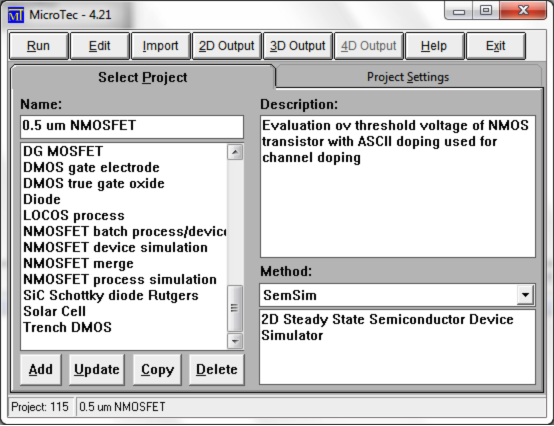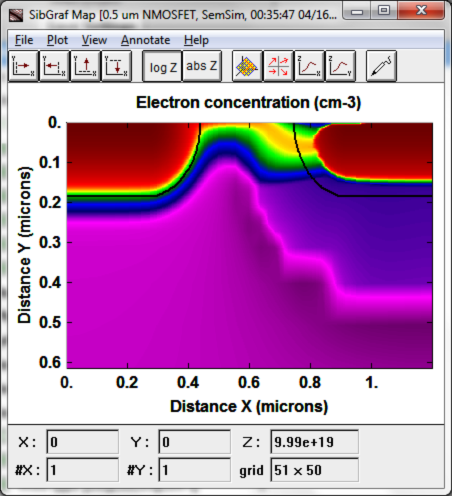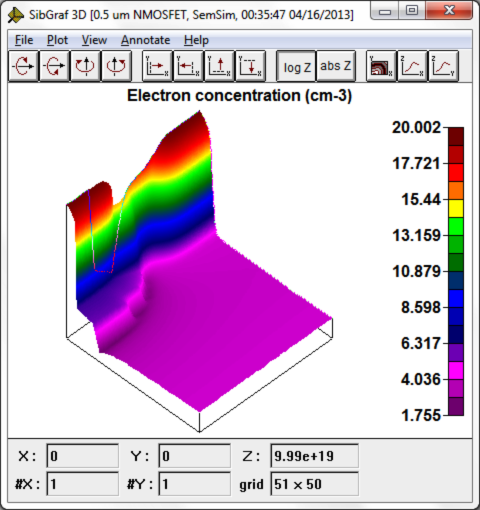MicroTec for Windows
Semiconductor Process and Device Simulator
Since its first commercial release in early 90's MicroTec semiconductor device simulator was used for education and research by 130+ Universities in more than 30 countries. The list includes leading academic institutions, such as University of California at Berkeley, University of Waterloo, Waseda University, Tokyo Institute of Technology, etc. The software was designed as a perfect supplement to any book on semiconductor devices or processes. It allows students to virtually make their own devices using a realistic process flow and test their performance. A limited capability version of this program was published by John Wiley & Sons as a supplement to Ton Mouthaan's book Semiconductors Devices Explained in 2000.
Being somewhat simplified compared to its semiconductor TCAD rivals, MicroTec was nevertheless used by more than 30 semiconductor companies including leading semiconductor manufacturers such as Hitachi, NTT, Matsushita, National Semiconductor, General Electric, Micron and Integrated Device Technology. In many cases MicroTec outperforms most of the commercial TCAD tools and it is particularly efficient for computationally extensive simulations arising in modeling of power semiconductor devices with large dimensions. MicroTec is also very useful for devices made of SiC, GaN and other materials with a wide bandgap, in particular it had been used for a few years at Cree Research for SiC device simulation. In the last five-six years MicroTec has become a choice simulator for Solar Cells.
From an engineer point of view the most crucial feature of MicroTec is its robustness. In addition it is very user-friendly and requires very little RAM. From the point of view of educational use, the main MicroTec feature is an ease-of-use. The latest version of MicroTec has a few new features such as graphical device structure editor, non-planar device modeling capability, etc.
You may download fully functional demo of the current version of MicroTec from our downloads page.
MicroTec includes three main software tools:
- SiDif for 2D semiconductor process simulation including implantation, diffusion, oxidation and epitaxy
- SemSim for steady-state 2D semiconductor device simulation
- SibGraf for 2D and 1D graphics
Semiconductor TCAD Calculator
Increasing performance of IBM PCs encourage the development of software tools that can be used for 2D/3D modeling of semiconductor devices and processes on a PC. Rather severe limitations on memory and speed of computation in previous generations of PCs forced development of new numerical techniques which formed the basis of the new generation of simulation tools. Some years ago a few efficient programs of this kind were developed which have been integrated together into a package named MicroTec.
MicroTec allows 2D silicon process modeling including implantation, diffusion, epitaxy and oxidation and 2D steady-state semiconductor device simulation including MOSFET, SOI-MOSFET, DMOS, JFET, BJT, IGBT, Schottky devices etc. Although MicroTec is significantly simplified compared to widely available commercial simulators, it nevertheless is a very powerful modeling tool used for industrial semiconductor process/device design. In many instances MicroTec outperforms existing commercial tools and it is remarkably robust and easy-to-use.

Top MicroTec is especially attractive for educational purposes due to its ease of use and robustness. It enables to develop a set of problems for a tutorial in semiconductor device physics with minimal effort. The goal of such a computer-aided course would be to give students basic ideas about the modern semiconductor device design in a realistic model environment.
 >
>
Despite apparent simplicity MicroTec covers basic needs for semiconductor process/device design complemented with efficient and flexible graphics tools. It is much easier to use than any other tool of its kind. MicroTec is a must for those who want to understand physics of semiconductor devices without knowing much about computers or numerical methods and who do not have much time for learning new process/device simulation tools. MicroTec is an excellent tool for managers, R&D engineers, students, professors and researchers and can be referred to as a TCAD calculator.

Top MicroTec is based on the diffusion-drift model and employs finite difference technique on a rectangular, auto-adjusting mesh.

MicroTec-4.23 is a true 32-bit application for Windows 2000, XP, Vista and Windows 7 and can be run on any PC. MicroTec-4.23 uses dynamic memory allocation. There is no memory threshold so it can be used even on a computer with only 1 Mbyte memory if the mesh size is not larger than about 2,000 nodes.

MicroTec-4.23 semiconductor device simulation tool requires about 8 Mbytes of memory for a 20,000 node mesh. Typical CPU time for one I-V point is less than 10 seconds on a typical PC when using mesh with 3,000 nodes.
For the process simulation tool, about 4 Mbytes of memory is required for a 20,000 node mesh. Simulation of a typical fabrication proces requires about a minute CPU time.